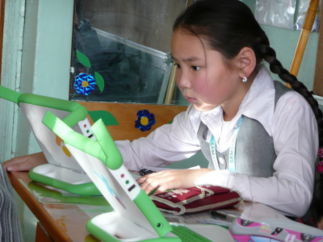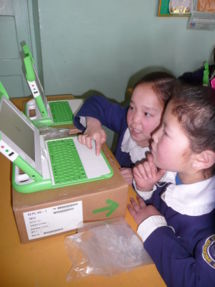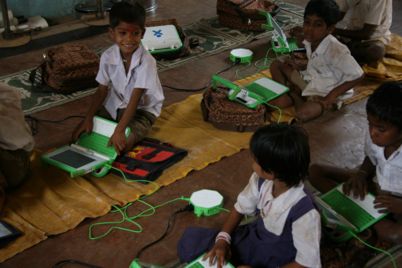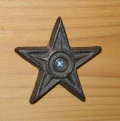User talk:FGrose
Thank you for considering the Safe XO use page. See the Talk:Safe XO use page for more of my thoughts and intentions. You may see that the task of communicating health, safety, or security information requires a subtle balance to integrate with more attractive content in order to avoid rejection. Often, we only intend to plant a seed idea that will begin to grow at a later time, but hopefully before an incident, so those involved will have some reference or guidance points.
I like your idea for reminder software in some activities. I like the format of the Desk-Trainer software, http://www.desk-trainer.com/. It is an example of how computer graphics can be used to assist in physical and health education. --FGrose 04:02, 5 February 2008 (EST)- It's really unfortunate that the XO has such bad ergonomics. Perhaps with proper input the Write activity could be given a RSI forced break for X seconds every Y minutes. Maybe a window with a suggested exercise for one's hands? I've seen similar programs. And teaching children basic stretches and ergonomics could go a long way.
- Anyway, drop me a line via email seth@isforinsects.com or on irc and I'll help you document your projects/concerns/interests. is for Insects 19:26, 4 February 2008 (EST)
Ergonomics/safety
We should plan to familiarize the ergonomics community with the OLPC project through professional societies and other associational contacts. The Western New York, Human Factors and Ergonomics Society local section merged its 26 March 2008 meeting with a walk-in workshop at the Rochester Institute of Technology. Posts in the Ergoweb Forum, OLPC, an education project, and a fledgling scientific distribution site, SciVee, direct interested parties to the OLPC wiki and the Health section. There are already several public health and human factors students involved in the project and many more interested.
Analysis of musculoskeletal disorders and their causes generally involves understanding the postures, forces, repetitions (frequencies, durations, and patterns) of movements and of recovery times or the complementary movements during rest periods that provide physiological relief to the tissues involved.
Repetitive strain and other overuse health problems are also very much affected by the age and physiological conditions of the tissues involved, and may also be affected by environmental stressors. On top of that, individual, interpersonal, group, and organizational behaviors are known to play important roles in the progression and recovery from musculoskeletal disorders. All this makes it a complex and easily convoluted problem.
We have learned a great deal from experience with adults, but published knowledge about children's susceptibilities and capacities is more limited. A recently published textbook, Ergonomics for Children, Designing products and places for toddlers to teens, Edited by Rani Lueder and Valerie Berg Rice [ Taylor & Francis 2008 ISBN 978-0-415-30474-0] is a reference I would recommend.
Those interested may also want to read articles such as this one just published, Children's Posture and Muscle Activity at Different Computer Display Heights and During Paper Information Technology Use, by Leon Straker, Robin Burgess-Limerick, Clare Pollock, Jemma Coleman, Rachel Skoss, and Barbara Maslen, Human Factors: The Journal of the Human Factors and Ergonomics Society, Volume 50, Number 1, February 2008 , pp. 49-61(13). (It should be available in a medical or engineering library near you.)
I found it interesting to see that some of the Mongolian children had their new XOs set up on the shipping box, which seems to help their back posture. The project's photos and video could be mined for other postures and behaviors as revealed in these photos by Carla Gomez Monroy, Learning Consultant, OLPC, 17 Jan 2008:
(See also this comment, Screen & posture.) Here is another user posture photo to consider: --FGrose 14:35, 20 March 2008 (EDT)The idea of studying postures could prove valuable in building an observation set of the variables I noted above for further technical study. Since all the photographs contain a standard XO with recognizable features, it might be possible to use 3D reconstruction software, such as used in Microsoft's Photosynth, to determine the relative position of the camera and then to calculate postural angles and positions of the XO users. Make3D is another new development for this from Stanford University. Those interested in studying XO–user ergonomics might start by reading some research papers and identifying professors or students currently working in biomechanics, work physiology, occupational or physical therapy, orthopedics, or any of the related fields.
From a software support point-of-view, one might be able to identify or coordinate some activity tracking software that could be used to collect quantitative information on the time patterns of various activities by individual users. There are some studies of this for adults, but there are no generally accepted exposure dosimetry standards in ergonomics. However, all the energy conservation work that is going into the XO hardware and software may lead to some really useful tools to begin to collect the raw data to support new discoveries for children's ergonomics.
We can continue to collect ideas and references on wiki pages as we work toward a critical mass of participation.
Thank you for your interest in the ergonomics of the XO.
- Looking forward, --FGrose 00:12, 14 February 2008 (EST)
- noticed you're one person behind the ergonomics project - would you mind filling me in on how that's going sometime? ergonomics is a special interest of mine (well, one of my many interests; my family has a history of carpal tunnel, I've gotten mild RSI before, and I'm hoping to run a project during the Health Jam or otherwise - or earlier, if possible (main limitation: my time and my access to components) - to test muscle strain and postural differences between various keyboards, "normal" laptops, and the XO for both kids and adults with different hand/finger/shoulder/etc. dimensions (and hopefully mobility, if we can find one-handed etc. typists). I know how to build test equipment, but almost nothing about how ergonomics tests are usually run, or ergonomics as a medial study proper.
- also, the students at Olin have equipment and know-how and the desire to run other safety tests on the XO (they'll be using impact testers, etc. in their materials science lab to check various physical qualities this coming weekend, including when dropping/smashing things might become a hazard) - I'll be there for the tests if you want to chime in on that as well. Contact info on my user page.
- Best, Mchua 14:34, 13 February 2008 (EST)
There is a wiki at Biomechanics Knowledge Repository that has a page on measuring techniques. The site has not been very active lately, but it has some good links. I'll poke around some more for open, online sources. --FGrose 02:31, 14 February 2008 (EST)
Here is a link to the International Ergonomics Association's Ergonomics for Children in Educational Environments Technical Committee's home page. They have a Research page with links to many accessible papers. --FGrose 20:16, 14 February 2008 (EST)- Thanks. All the resources you linked were to articles and books you need to purchase, though - do you have any pointers for good free resources or papers on ergonomics testing and testing equipment/software? (Beyond the usual "search google and wikipedia for whatever terms you know," of course - I'll do that, but you probably know how to hone in on the good stuff faster.) Mchua 01:36, 14 February 2008 (EST)
Keystroke monitoring
The hardware clocks in the XO probably report a count based on the the chip frequency. If a log of the counts is recorded for each keystroke, the data can be analyzed to calibrate a work model.
The exponentially weighted moving average (EWMA) is a well-studied, simple, and robust model useful for realtime process control systems. It is calculated by the formula,where yi is the EWMA at keystrokei, ti and ti-1 are the timer counts for keystrokei and keystrokei-1 (two consecutive keystrokes), and yi-1 is the preceding estimate of the EWMA.
λ is a smoothing parameter that represents the weighing fraction (0 < λ ≤ 1) or contribution of the latest datum to the average and (1 - λ) represents the contribution of the historical data. When λ = 1, there is no contribution from historical data so no smoothing occurs (the model tracks the raw data).
For the goal of monitoring frequent events occurring perhaps once per second or so, with a long averaging period of around 15 minutes, a λ of 0.01 might be a suitable smoothing constant (but some testing trials and sensitivity evaluations should be undertaken).- In response to a proposal to program a Typing Tutorial activity, this response was shared with Kate Scheppke on the Devel mailing list:
- Hi Kate,
- Please consider the ergonomic and safety aspects of this learning activity. I remember well how my piano teacher provided protective oversight by watching my activities even during a short, 30-minute, weekly lesson. She had me pause and rest for a couple of minutes, after about 15 minutes of continuous or even shorter periods of intense keyboarding.
- If you could incorporate code to accommodate an algorithm that monitors typing intensity, such as, keystroke rate and continuity, this could be used to issue appropriate reminders to the user to rest their hands, eyes, and other body parts from intense activity.
- A simple algorithm might be one that monitors the exponentially weighted moving average of time between keystrokes based on accumulation of the output of a timer counter that is read at each keystroke.
- Some calibration of the work model parameters with actual use data will be needed to set reasonable triggers for the rest reminders.
- Having such an "on-board safety coach" would be of great advantage in building an awareness of the body's physiology and it's limits, and contribute another important lesson for the child's safe growth and maturation.
- I've posted a formula for the exponentially weighted moving average on the OLPC wiki at Keystroke monitoring.
- There is also some discussion of XO ergonomics at Ergonomics/safety.
- Please write if you would like more assistance.
- Best wishes, Frederick Grose, MPH, CIH
Welcome!
Welcome to the One Laptop per Child wiki. Please make yourself at home; read through the Table of Contents and FAQ, and take a look around. If you need a general wiki-tutorial, Wikieducator has some excellent ones.
Great starting points...
- Volunteer - Volunteer program.
- Simplified_users_guide - How to use your new XO.
- Ask OLPC a Question - a place to start with questions.
- Support - Support for any issues or questions.
- OLPC:News - Weekly news of OLPC.
Here are some ways you can....
- Contribute - Would you like to give some of your work, expertise, or time to OLPC ?
- Participate - Many ways you can be part of the OLPC community .
- Pictures - Are you a Photographer ? Like to organize images, or have collections ?
- Translation - Do you speak, read, or write multiple languages, your help is needed !
- Wiki cleanup - Have wiki background, or just like to edit or merge info together, page just for you.
Also remember to check your preferences and be sure you verify your email address and turn on email notification if you'd like it -- you can find out when your talk page, or any page on your watchlist, is modified. You may want to upload a photo or information about yourself to your userpage.
Examples: User:Mchua, User:Ixo
Feel free to leave me a note on my talk page if you have further questions or need help finding your way around. :-)
Cheers, ixo (talk or discussion)
--ixo 18:17, 12 February 2008 (EST)
Memebrand
Thanks for the pointer. I'm just wondering if it's just something put there in December 07 or it it's really being pursued. Recently there seems to be some activity out of XOAustin on exploring DITA as a tool, see Projects/Wikislice. I'm increasingly of the opinion that the apparent absence of a clearly defined content generation and submission process is a "blocker" for real progress on populating the Library. To that end, I'm drafting some ideas on the earlier phases of the content collection process for wiki posting and kicking some ideas around with isforinsects and mchua on how to create a concerted effort (documented and reproducible) to go about grabbing some of the low-hanging fruit health content that's out there. This will have a tendency to force the issue on what to do with the content gathered and hopefully we can leave a trail of breadcrumbs that will make it easier for other content developers to close the loop from idea to Library submission. Cjl 00:31, 27 April 2008 (EDT)
Usability
Thanks for creating the usability category, and putting my Pen_Tablet_UI/User_Study article in it. I had promised on the mailing list to put together some usability resources on the wiki, but hadn't gotten around to it yet. --pdubroy 18:36, 1 May 2008 (EDT)
greetings
Hi FGrose, are you still around? I'd like to chat with you about memebrand at some point! --Sj talk 00:20, 27 December 2008 (UTC)
Wiki sysop
Fred, I've put you name forward as a potential wiki sysop. I've seen and appreciated your recent wiki-patrolling and I think you would find sysop (wiki admin) priv a help in improving the wiki. Please make a note on the Administrators page if you would accept sysop nomination and share that responsibility (if approved by wiki peers). cjl 03:08, 12 March 2009 (UTC)
Test message alert
will this initiate a message alert to myself?
- only if you set your preferences so that you get email when your talk page is edited (and have entered a valid email address). you can also get email when a page you are watching on your watchlist is edited. --Sj talk 01:01, 25 March 2009 (UTC)
I was thinking of the on-page message alerting service. See this inquiry: User_talk:Sj#User_talk:_page_message_notifications. Thanks!
Why do you say that the OLPC News forum is not frequented by core developers?
AFAIK, they do not frequent any other public forum either... ![]() Yamaplos 21:22, 30 March 2009 (UTC)
Yamaplos 21:22, 30 March 2009 (UTC)
- No disagreement, I just copied the distinction that was made at http://wiki.sugarlabs.org/go/Sugar_Labs/Contacts#Forums with insufficient consideration. How would you distinguish the two forums, or is it even necessary? --FGrose 23:54, 30 March 2009 (UTC)
mop and bucket
You are now a janitor administrator. Use your mop and bucket wisely! --Sj talk 17:08, 29 June 2009 (UTC)
- Hello FGrose! Please vote on the latest admin noms when you have a moment. --Sj talk 22:22, 18 December 2009 (UTC)
Huzzah for local events
Don't forget to categorize your event pages :) --Sj talk 23:31, 26 January 2010 (UTC)
A squeaky clean barnstar for you
Hello FGrose, thank you for your lovely work keeping the wiki clean! --Sj talk 16:17, 21 September 2011 (UTC)






